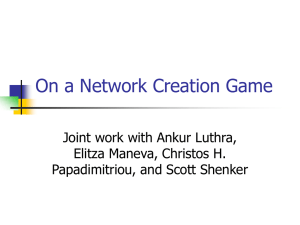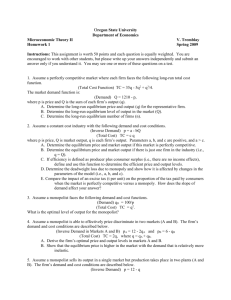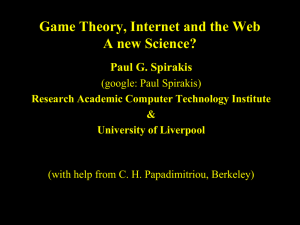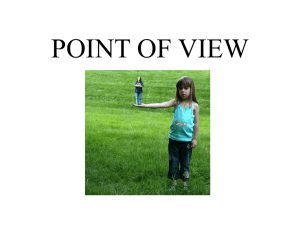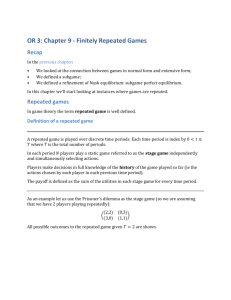On a Network Creation Game
advertisement
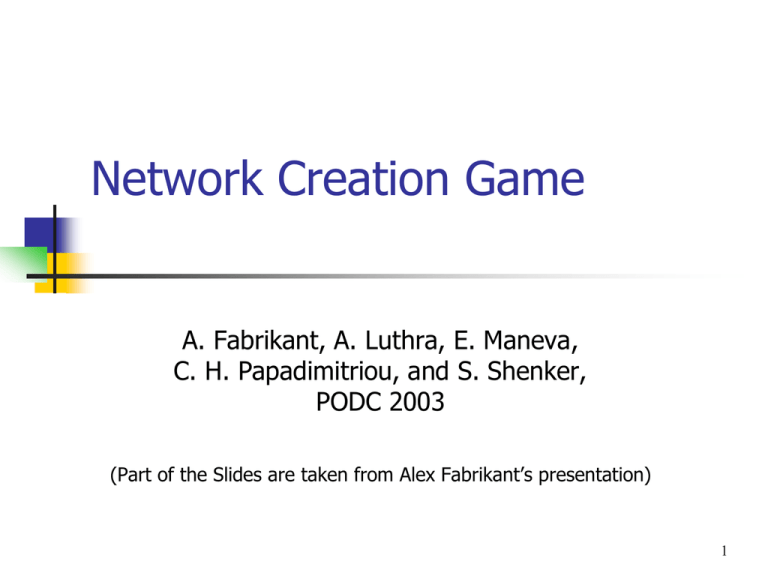
Network Creation Game
A. Fabrikant, A. Luthra, E. Maneva,
C. H. Papadimitriou, and S. Shenker,
PODC 2003
(Part of the Slides are taken from Alex Fabrikant’s presentation)
1
Context
U
C
B
E
R
K
E
L
E
Y
C
O
M
P
U
T
E
R
S
C
I
E
N
C
E
The internet has over 20,000
Autonomous Systems (AS)
Every AS picks their own peers to
speed-up routing or minimize cost
2
Question:
What is the performance penalty in
terms of the poor network structure
resulting from selfish users creating
the network, without centralized
control?
Goal of the paper
U
C
B
E
R
K
E
L
E
Y
C
O
M
P
U
T
E
R
S
C
I
E
N
C
E
Introduces a simple model of network
creation by selfish agents
Briefly reviews game-theoretic concepts
Computes the price of anarchy for different
cost functions
4
A Simple Model for constructing G
U
C
B
E
R
K
E
L
E
Y
C
O
M
P
U
T
E
R
S
C
I
E
N
C
E
N agents, each represented by a vertex and can
buy (undirected) links to a set of others (si)
One agent buys a link, but anyone can use it
Cost to agent:
Distance from i to j
Pay $a for each
link you buy
Pay $1 for every
hop to every node
(a may depend on n)
5
Example
U
C
B
E
R
K
E
L
E
Y
C
O
M
P
U
T
E
R
S
C
I
E
N
C
E
2
-1 3
-3
4
1
+a
2
1
a
c(i)=a+13
c(i)=2a+9
(Convention: arrow from the node buying the link)
6
Definitions
U
C
B
E
R
K
E
L
E
Y
C
O
M
P
U
T
E
R
S
C
I
E
N
C
E
V={1..n} set of players
A strategy for v is a set of vertices Sv V\{v}, such
that v creates an edge to every w Sv. G(S)=(V,E) is the
resulting graph given a combination of strategies
S=(S1,..,Sn), V set of players / nodes and E the laid
edges.
Social optimum: A central administrator’s approach to
combining strategies and minimizing the the total cost
(social cost) It may not be liked by every node.
Social cost: C(G) ci a E dG (i, j )
i
i, j
7
Definitions: Nash Equilibria
U
C
B
E
R
K
E
E
Y
C
O
M
P
U
T
E
R
S
C
I
E
N
C
E
Nash equilibrium: a situation such that no
single player can unilaterally modify its
strategy and lower its cost
L
Presumes complete rationality and knowledge
on behalf of each agent
Nash Equilibrium is not guaranteed to exist, but
they do for our model
The private cost of player i under s:
C (i, S ) a Sv dG (i, j )
j
8
Definitions: Nash Equilibria
U
C
B
E
R
K
E
L
E
Y
C
O
M
P
U
T
E
R
S
C
I
E
N
C
E
A combination of strategies S forms Nash
equilibrium, if for any player i and every other
strategy U (such that U differs from S only in i’s
component)
C (i, S ) C (i,U )
G(S) is the equilibrium graph.
9
Example ?
U
C
B
E
R
K
E
L
E
Y
C
O
M
P
U
T
E
R
S
C
I
E
N
C
E
Set a=5, and consider:
+1
-2
-1
-5
-1
+2
-1
+5
+5
+5
-5
+4
+1
-1
-5
-5
+1
10
Definitions: Price of Anarchy
U
C
B
E
R
K
E
L
E
Y
C
O
M
P
U
T
E
R
S
C
I
E
N
C
E
Price of Anarchy (Koutsoupias & Papadimitriou,
1999): the ratio between the worst-case social
cost of a Nash equilibrium network and the
optimum social cost over all Nash equilibria.
We bound the worst-case price of anarchy to
limit “the price we pay” for operating without
centralized control
11
Social optima for a < 2
U
C
B
E
R
K
E
L
E
Y
C
O
M
P
U
T
E
R
S
C
I
E
N
C
E
When a < 2, the social optima
is a clique. Any missing edge
can be added adding a to the
social cost and subtracting at
least 2 from social cost.
A clique
12
Nash Equilibrium for 1<a<2
U
C
B
E
R
K
E
L
E
Y
C
O
M
P
U
T
E
R
S
C
I
E
N
C
E
When 1<a<2, the worst-case
equilibrium configuration is a
star. The total cost here is
(n-1)a + 2n(n-1) - 2
In a Nash Equilibrium, no single node can unilaterally
add or delete an edge to bring down its cost.
13
Social optima for a > 2
U
C
B
E
R
K
E
L
E
Y
C
O
M
P
U
T
E
R
S
C
I
E
N
C
E
When a > 2, the social
optima is a star. Any
extra edges are too
expensive.
C (star) (n 1)(a 2(n 1))
14
Complexity issues
U
C
B
E
R
K
E
L
E
Y
C
O
M
P
U
T
E
R
S
C
I
E
N
C
E
Theorem. Computing the best response of
a given peer is NP-hard.
Proof hint. When 1 < a < 2, for a given
node k, if there are no incoming edges,
then the problem can be reduced to the
Dominating Set problem.
15
Equilibria: very small a (<2)
U
C
B
E
R
K
E
L
E
Y
C
O
M
P
U
T
E
R
S
C
I
E
N
C
E
For a<1, the clique is the only N.E.
For 1<a<2, clique no longer N.E., but
the diameter is at most 2
-2
+a
Then, the star is the worst N.E., can be
seen to yield P.o.A. of at most 4/3
16
P.O.A for very small a (<2)
U
C
B
E
R
K
E
L
E
Y
C
O
M
P
U
T
E
R
S
C
I
E
N
C
E
The star is also a Nash
equilibrium, but there may be
worse Nash equilibrium.
17
P.O.A for very small a (<2)
U
C
B
E
R
K
E
L
E
Y
C
O
M
P
U
T
E
R
S
C
I
E
N
C
E
Proof.
18
The case of a > n2
U
C
B
E
R
K
E
L
E
Y
C
O
M
P
U
T
E
R
S
C
I
E
N
C
E
The Nash equilibrium is a tree, and the
price of anarchy is 1.
Why?
19


